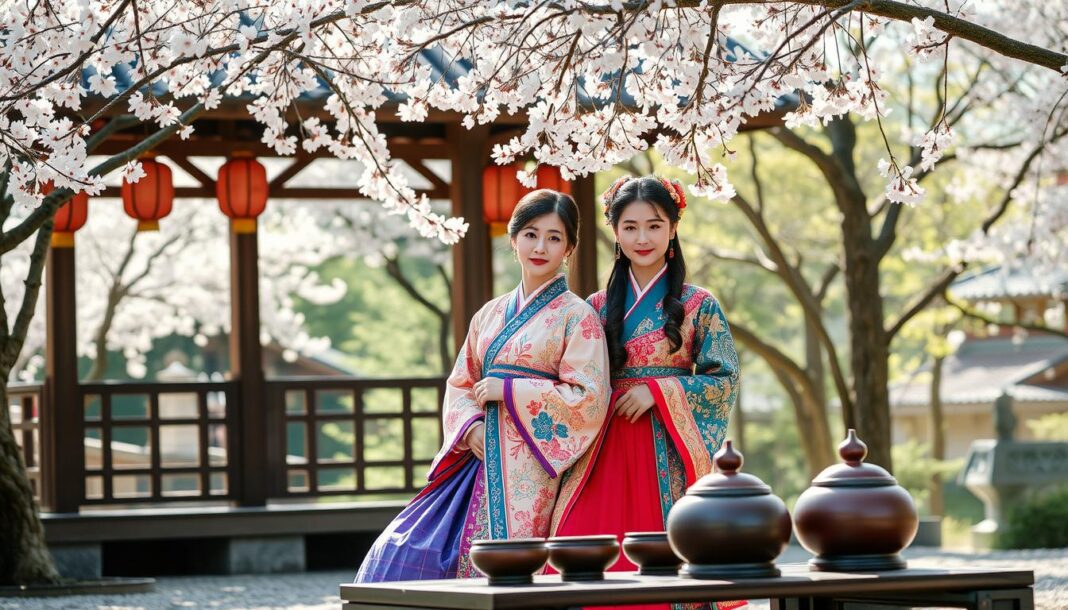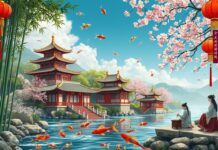Start an exciting journey through Korean culture. It’s filled with unique Hangul writing and the hit K-pop music. This article will show you the many sides of Korean culture.
Learn about Korea’s art, food, history, and more. Get ready to dive into the beauty and depth of this lively culture.
Key Takeaways
- Discover the unique Hangul writing system, a hallmark of Korean culture
- Explore the global impact of K-pop, a vibrant musical genre
- Dive into the rich artistic heritage of Korea, from art to architecture
- Savor the flavors of Korean cuisine, a delectable fusion of tradition and innovation
- Uncover the fascinating history and traditions that shape Korean culture
Unveiling the Rich Tapestry of Korean Culture
Korea’s culture is vibrant and full of tradition and change. It has ancient roots and modern expressions that grab the world’s attention. This country’s cultural heritage is a rich tapestry worth exploring.
A Journey Through Centuries of Tradition
Korean traditions come from a long and rich past. They include grand dynasties and the people’s resilience. These traditions are part of everyday life, showing respect for ancestors, nature, and harmony.
From Ancient Roots to Modern Expressions
Korea has changed with modern times, blending old traditions with new ones. See the hanbok dance and K-pop shows together. Korean art and architecture mix old techniques with modern styles.
| Ancient Traditions | Modern Expressions |
|---|---|
| Hanbok (traditional Korean dress) | High-fashion adaptations of the hanbok |
| Calligraphy and brush painting | Contemporary art installations and digital media |
| Confucian scholar-official culture | Fusion of traditional and global influences |
“Korea’s cultural heritage is a tapestry of timeless elegance and modern vibrancy, woven together by the threads of its rich history and the creativity of its people.”
The Beauty of Hangul: Korea’s Unique Writing System
In the world of Hangul, Korea’s unique writing system, we find a true source of national pride. This cleverly designed script has helped spread the Korean language far and wide. It has also kept the rich cultural heritage of the Korean people alive.
Hangul’s characters are each carefully made to show the Korean language’s subtleties. They show the deep bond between written words and Korean culture. Hangul’s simplicity and ease of use have made it very popular and helped it last for a long time.
The beauty of Hangul is in its mix of practicality and art. Each jamo is a clever way to show the spoken language. This makes it easy for people to learn and read. It shows the creativity and skill of the Korean people.
“Hangul is a true masterpiece of design, a written language that seamlessly bridges the gap between form and function.”
Exploring Hangul and the Korean language reveals a deep respect for the connection between script, culture, and identity. This unique writing system is a symbol of the Korean people’s spirit. It celebrates their rich heritage and shows their lasting national pride.
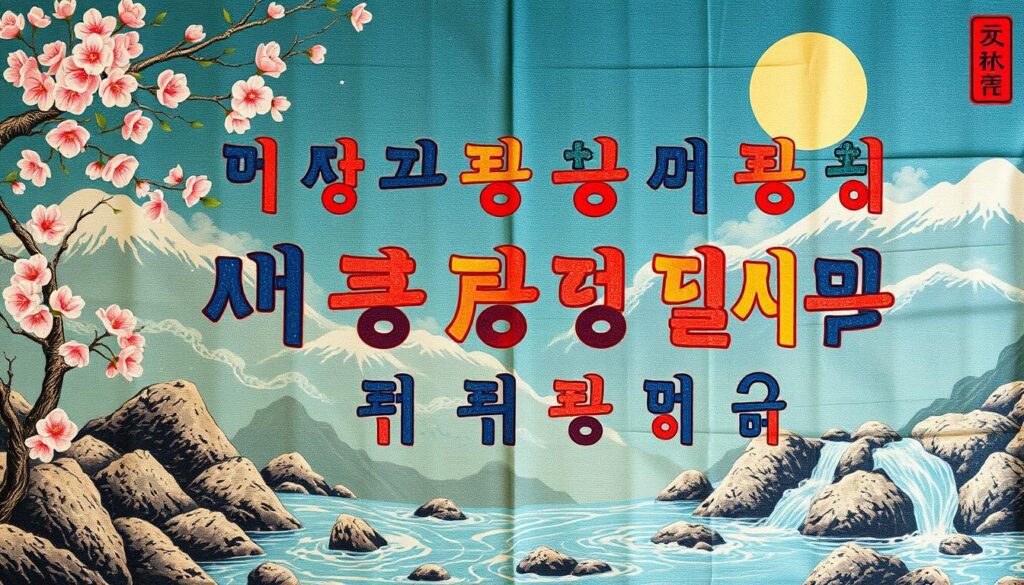
| Hangul Consonants | Hangul Vowels |
|---|---|
| ㄱ, ㄴ, ㄷ, ㄹ, ㅁ, ㅂ, ㅅ, ㅇ, ㅈ, ㅊ, ㅋ, ㅌ, ㅍ, ㅎ | ㅏ, ㅑ, ㅓ, ㅕ, ㅗ, ㅛ, ㅜ, ㅠ, ㅡ, ㅣ |
Korean Culture: An Exploration of Art and Architecture
Korea’s rich culture shines through in its stunning art and architecture. From ancient times to today, Korean artists and architects have made incredible works. These pieces inspire and amaze both locals and visitors. Dive into the world of Korean art and Korean architecture to see the beauty and lasting impact of these cultural expressions.
Masterpieces That Inspire and Captivate
The Korean Peninsula has always been a place of artistic and architectural innovation. Traditional Korean paintings show beautiful landscapes and fine brush strokes. They are loved for their timeless beauty. The country’s buildings, like grand palaces and detailed temples, have lasted for centuries. They show the skill and creativity of their makers.
| Korean Art Masterpiece | Korean Architectural Masterpiece |
|---|---|
| The Painting of the Peach Blossom Spring by Kim Hong-do | Gyeongbokgung Palace in Seoul |
| The Mural Paintings of Goguryeo Tombs | Bulguksa Temple in Gyeongju |
| The Monochrome Painting Landscapes by Jeong Seon | Hwaseong Fortress in Suwon |
These art and architecture pieces show the skill of their creators. They also reflect Korea’s cultural values and traditions. As you explore these masterpieces, you’ll understand the depth of Korean culture and its lasting impact on the world.
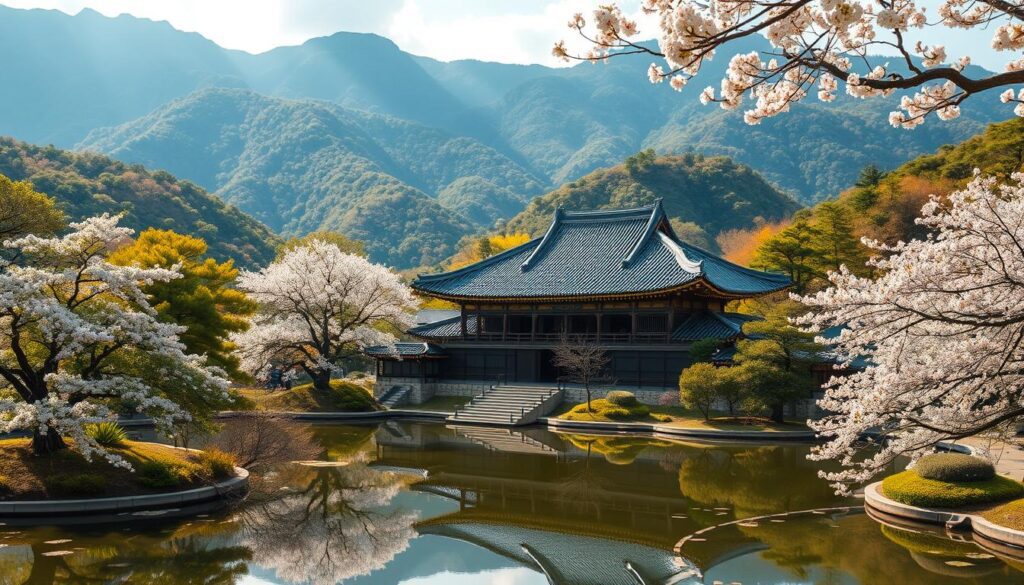
“The true beauty of Korean art lies in its ability to capture the essence of nature and the human experience, transcending time and space to evoke a profound emotional response.”
Immerse Yourself in the Flavors of Korean Cuisine
Start a food journey through the lively world of Korean cuisine. It’s a mix of old ways and new tastes, creating dishes that excite your senses.
The star of Korean food is kimchi, a fermented veggie dish loved by all. It shows the rich flavors and traditions of Korean cooking.
A Delectable Fusion of Tradition and Innovation
Korean cuisine offers more than just kimchi. You’ll find dishes like bibimbap and bulgogi, each with its own story. They reflect Korea’s rich history and culture.
Today, Korean food is also known for its bold new flavors. It combines old tastes with modern cooking, making it a hit worldwide.
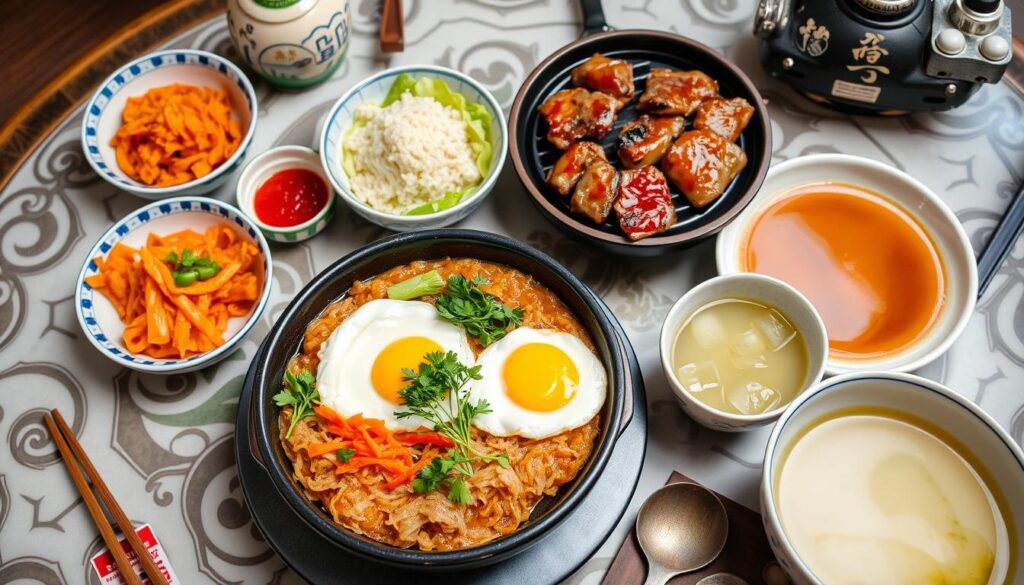
“The essence of Korean cuisine lies in its ability to balance the interplay of flavors, textures, and cultural traditions, creating a captivating gastronomic experience that is both familiar and transcendent.”
If you love food, exploring Korean cuisine is a must. It’s a journey that will make you want more.
Korean Fashion: From Traditional Hanbok to Modern Chic
Korean culture is rich and diverse, seen in both ancient traditions and modern fashion. The hanbok, known for its timeless beauty, has evolved into today’s trendy styles. Korean fashion has changed a lot over time.
Korean designers mix old skills with new ideas. They update the hanbok with modern shapes and bright colors. This mix of old and new has created a unique style that shows off Korea’s lively culture.
| Traditional Hanbok | Modern Korean Fashion |
|---|---|
| Timeless elegance, intricate embroidery, and vibrant colors | Sleek, minimalist designs, innovative silhouettes, and global influence |
| Rooted in centuries-old traditions | Blending traditional elements with avant-garde aesthetics |
| Worn on special occasions and cultural events | Integrated into everyday streetwear and high-fashion runways |
Korean fashion is now loved around the world. It combines tradition and modernity in a unique way. Korean designers are changing fashion, showing off Korea’s rich culture on the global stage.
“Korean fashion is a testament to the country’s ability to honor its past while embracing the future. It’s a sartorial celebration of a dynamic, ever-evolving culture.”
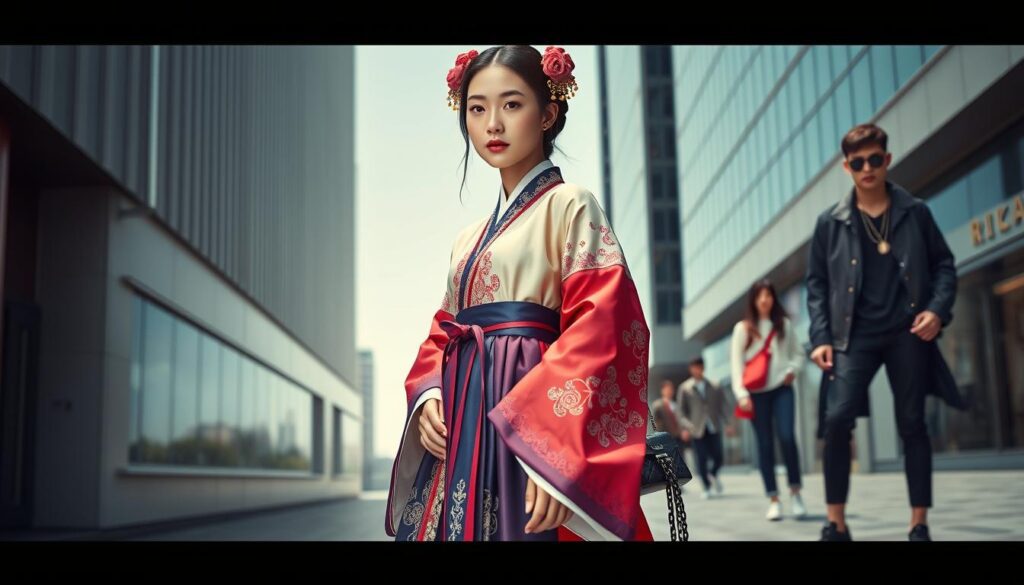
The Global Phenomenon of K-Pop
K-pop, the lively Korean pop music, has stormed the global music scene. It’s known for its catchy tunes, stunning dance moves, and charming artists. This genre has won the hearts of millions, crossing cultural lines.
Capturing Hearts with Catchy Beats and Vibrant Performances
K-pop’s charm comes from blending Korean music traditions with modern Western styles. This mix creates a unique sound. It’s filled with catchy melodies, detailed dance moves, and eye-catching performances.
K-pop artists are known for their amazing voices, energetic stage presence, and perfect dance moves. They have won fans from Seoul to Sydney, sparking a global K-pop frenzy.
K-pop fans, or “K-pop stans,” are a big part of the genre’s success. They form online communities, hold streaming events, and vote for their favorite idols. Their love and support have helped K-pop become a global sensation.
| Top K-pop Artists | Notable Achievements |
|---|---|
| BTS | First K-pop group to reach #1 on the Billboard Hot 100 chart, record-breaking album sales, and numerous awards |
| Blackpink | First K-pop girl group to perform at Coachella, record-breaking music video views, and multiple chart-topping hits |
| Twice | One of the best-selling K-pop girl groups, with numerous hit songs and awards |
K-pop’s global success shows music’s power to unite people across cultures. As K-pop grows, its future looks bright for music lovers everywhere.
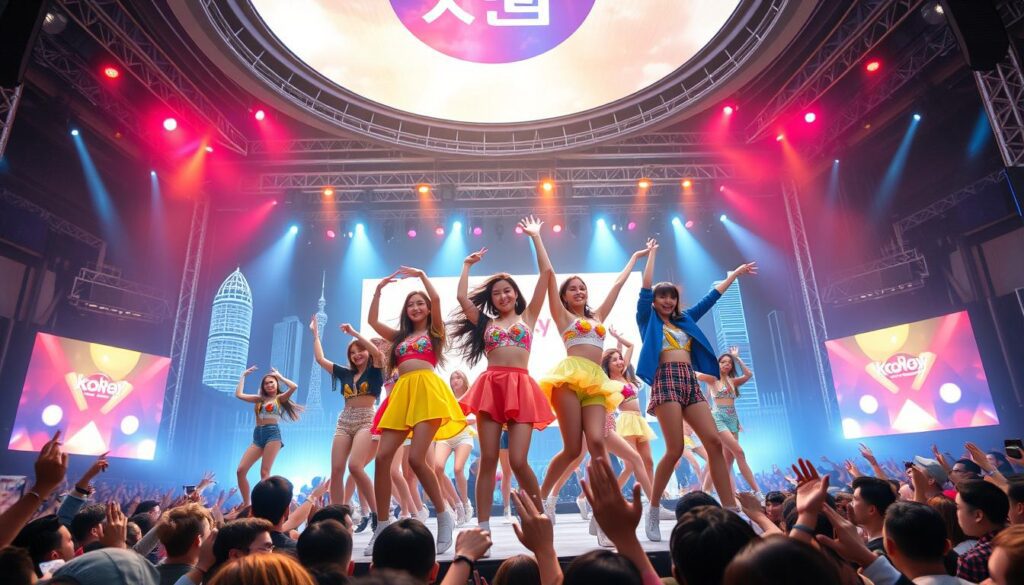
Korean Culture Through the Lens of History
The rich tapestry of korean history has deeply shaped the Korean people’s cultural identity. From ancient dynasties to modern-day triumphs, Korea’s journey is marked by resilience and spirit.
Exploring korean history reveals a captivating story that has deeply influenced Korea’s culture. Key events, like the rise and fall of kingdoms, have shaped Korea’s art, architecture, and traditions.
The korean history shows the nation’s ability to adapt and thrive through challenges. Despite struggles and triumphs, the Korean people have kept their cultural identity strong. They have preserved and passed down their heritage to future generations.
By diving into korean history, we appreciate the mix of ancient traditions and modern influences in Korean culture. From the Goguryeo dynasty to K-pop, Korea’s story is one of resilience, creativity, and cultural excellence.
| Era | Highlights |
|---|---|
| Ancient Dynasties | Emergence of the Three Kingdoms (Goguryeo, Baekje, and Silla) Development of distinctive architecture, art, and religious practices |
| Goryeo and Joseon Periods | Establishment of the Goryeo and Joseon dynasties Advancements in Confucian philosophy, literature, and the creation of Hangul |
| Modern Era | Struggle for independence and the formation of the Republic of Korea Rapid economic growth and the rise of Korean pop culture (K-pop) |
Diving into korean history helps us understand the resilience and cultural richness of the Korean people. This journey through time offers valuable insights and inspires a deeper appreciation for Korea’s spirit.
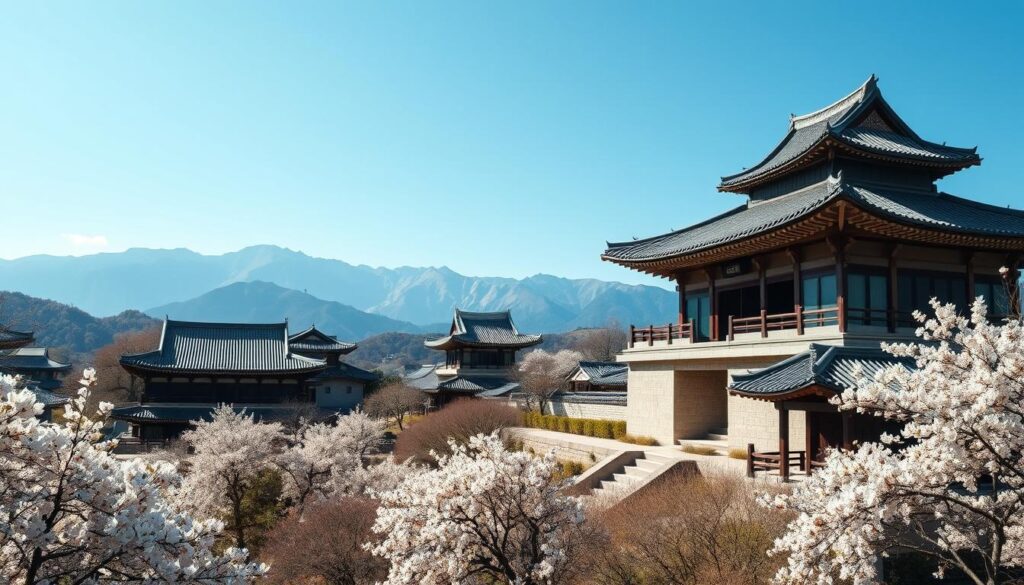
Korean Traditions: A Window into a Vibrant Cultural Heritage
Korea’s cultural heritage is a mix of ancient traditions that still shape the Korean identity. The country’s korean festivals celebrate the seasons, and its korean traditions are rooted in history. This rich culture offers a glimpse into a world of deep cultural richness.
Celebrating Festivals and Rituals
Korean culture is known for its lasting festivals and rituals. These events honor the past, connect with today, and look forward to tomorrow. Festivals like the Lunar New Year and the Chuseok harvest festival are filled with spirituality, community, and joy.
- Lunar New Year (Seollal): This festival marks the start of the lunar calendar. It’s celebrated with family, traditional food, and the iconic hanbok clothes.
- Chuseok (Harvest Moon Festival): In autumn, Koreans honor their ancestors, share food, and make songpyeon dumplings.
- Dano Festival: Held on the fifth day of the fifth lunar month, it celebrates the seasons. It features colorful parades, games, and sujebi dumplings.
These festivals and rituals, based on ancient beliefs and farming, still thrive in Korea today. They give us a glimpse into the nation’s enduring cultural spirit.
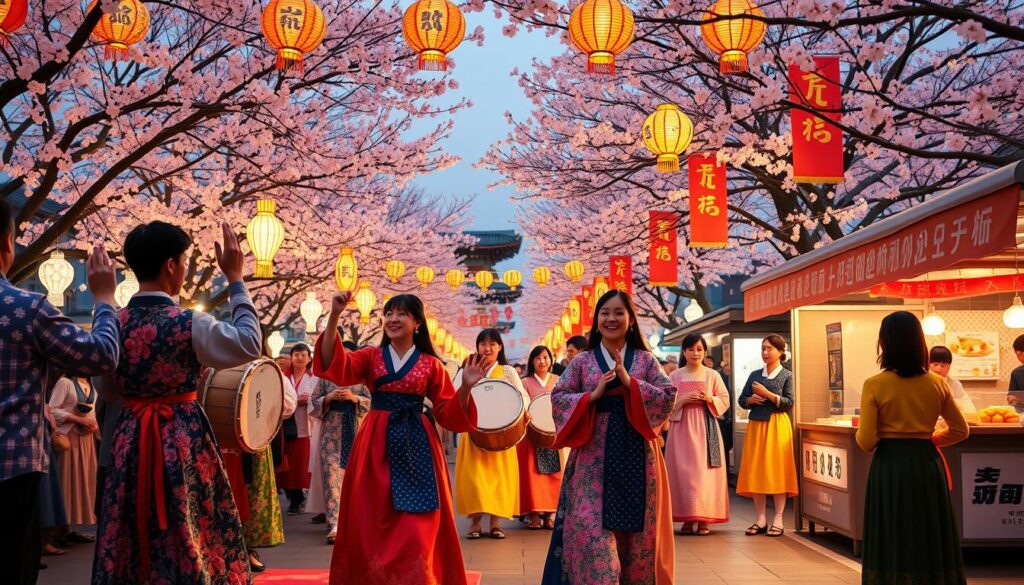
| Festival | Significance | Key Traditions |
|---|---|---|
| Lunar New Year (Seollal) | Marks the start of the lunar calendar | Family gatherings, traditional feasts, wearing hanbok |
| Chuseok (Harvest Moon Festival) | Honors ancestors and the autumn harvest | Paying respects to ancestors, sharing songpyeon dumplings |
| Dano Festival | Celebrates the changing of the seasons | Colorful parades, folk games, eating sujebi dumplings |
“The traditions of Korea are not just a relic of the past, but a living, breathing expression of the nation’s cultural identity. Each festival and ritual serves as a touchstone, connecting the present to the rich tapestry of Korea’s storied history.”
The Martial Art of Taekwondo: A Korean Cultural Gem
Taekwondo is a symbol of Korea’s rich culture. It’s a dynamic self-defense art with deep roots in tradition. Its powerful moves, disciplined training, and philosophical principles have won the world’s admiration.
At its core, taekwondo honors Korea’s history and identity. It started from ancient martial arts and has grown over centuries. It’s more than a physical activity; it’s a way of life that balances body, mind, and spirit.
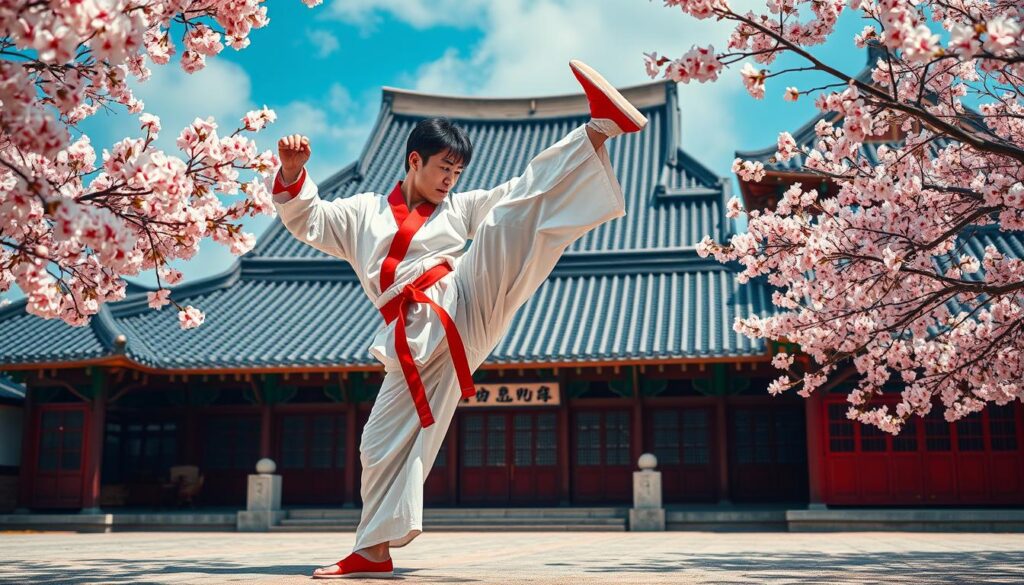
The art’s principles mirror Korean values like respect, humility, and personal growth. Through hard training, taekwondo students learn to control their energy and discipline. They also develop self-control.
Taekwondo has become a source of pride for Koreans. It has grown from a local art to a global phenomenon. Its inclusion in the Olympics has made it a celebrated cultural icon, showcasing Korean martial arts’ beauty and strength worldwide.
| Taekwondo Principles | Cultural Significance |
|---|---|
| Respect | Rooted in Confucian values and the Korean reverence for elders and authority |
| Discipline | Reflects the Korean emphasis on personal growth, self-control, and commitment |
| Perseverance | Echoes the Korean spirit of resilience and overcoming challenges |
| Indomitable Spirit | Embodies the Korean people’s unwavering determination and pride |
As taekwondo wins hearts globally, it showcases Korea’s lasting strength and cultural wealth. It’s not just a physical activity but a living symbol of Korea’s traditions and values. Thus, it is a true Korean cultural gem.
Korean Culture: Embracing Modernity While Honoring the Past
Korean culture is a story of balance and growth. The nation has welcomed modernity while keeping its traditions alive. This mix of old and new creates a vibrant culture that stands out.
Korea has adopted new technologies and global trends. Yet, it has not lost its cultural roots. This shows how the country values its heritage while moving forward.
At the core of Korean culture is a deep respect for history and a look towards the future. The culture has changed over time but stays true to its roots. The hanbok and K-pop are examples of this blend.
This balance between old and new shows Korean culture’s strength and flexibility. As Korea grows, it keeps its identity strong. This ensures its rich history continues to inspire future generations.
FAQ
What is the significance of Hangul, the Korean writing system?
Hangul is the unique writing system of the Korean language. It’s a source of national pride for Koreans. Its design and ease of use have made it widespread, showing the richness of Korean language and culture.
What are some of the key elements of traditional Korean art and architecture?
Korean art and architecture are filled with timeless masterpieces. These creations have evolved over centuries. They showcase the unique Korean flair in both traditional paintings and architectural marvels.
What are the defining characteristics of Korean cuisine?
Korean cuisine is a mix of tradition and innovation. It has a rich history and diverse flavors. From kimchi to modern fusion dishes, it blends old techniques with new ideas.
How has Korean fashion evolved from traditional hanbok to modern styles?
Korean fashion combines old craftsmanship with new styles. It reflects the country’s cultural richness. The hanbok’s elegance meets modern trends, captivating people worldwide.
What is the significance of K-pop in Korean culture?
K-pop has become a global sensation. It’s known for its choreography, melodies, and fan communities. K-pop shows the dynamism and creativity of Korean culture, earning international acclaim.
How have Korean traditions and festivals contributed to the country’s cultural heritage?
Korean traditions and festivals celebrate the country’s heritage. They range from ancient customs to modern celebrations. These practices define Korean identity and show the country’s evolving spirit.
What is the significance of taekwondo in Korean culture?
Taekwondo is a revered martial art in Korea. It’s rooted in ancient philosophy and physical discipline. Taekwondo has become a cultural symbol and a source of national pride.
How does Korean culture balance modernity with its rich heritage?
Korean culture blends modernity with tradition. It has adopted technology and global trends while preserving its heritage. This balance allows its rich culture to thrive in a changing world.
To read the latest articles please visit the home page of Turk Blogs.


